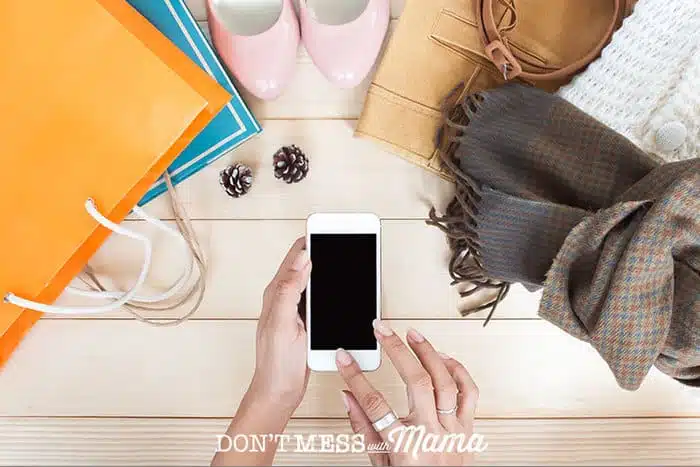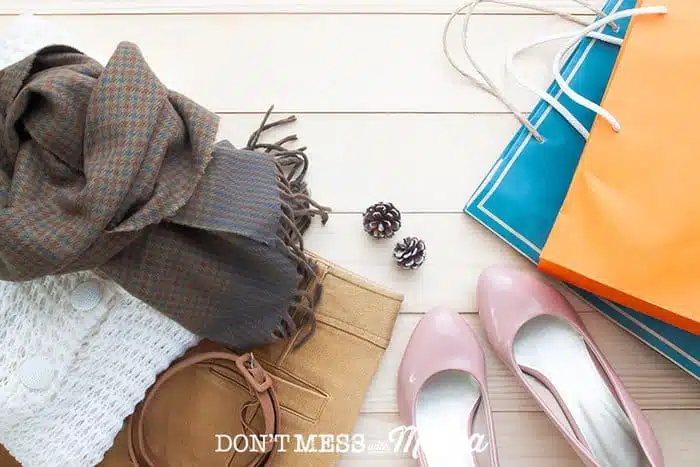5 Questions to Ask Before You Buy
Going shopping? Check out these 5 questions to ask before you buy. Learn practical tips to shop like a minimalist to save space, save money and keep the clutter out.
This post contains affiliate links. Please read my affiliate disclosure.

Did you know there are more self-storage buildings in America than there are McDonald’s and Starbucks combined? That’s pretty staggering considering there’s a Starbucks on every corner where I live in Southern California.
Yep, it’s true. There are more than 50,000 self-storage facilities in the US in 2018. That’s more than McDonald’s (14,000), and Starbucks (14,000) combined. Yet, most Americans (at least 65%) who rent a storage unit have their own garage.1
And we’re paying a pretty penny for it too… about $37 billion a year on storage. That’s an average cost of about $90 a month. A 10 x 10 feet unit is the most common unit that’s rented, which is about the size to store 2-4 rooms of furniture.2
What does that mean? We’re buying too much stuff. We buy more than we need and we’ve run of out places to store all that stuff our own homes, so we pay even more money to store it someplace else.
It’s time to really think about whether you need the things you buy.
How to Shop Like a Minimalist
Shopping like a minimalist isn’t about Scandinavian furniture and black and white clothes. It’s really about asking why before you buy. It’s about being intentional about buying things to get what you really need (and want) and purposeful about where it will live in your home.
Asking yourself these questions will help to save you time, save you money, and cut down on the clutter in your home so you’ll never need to get storage space to store things you don’t need.
Just getting started with minimalism? I’ve got practical tips to help you get started: 5 Reasons Why You Should Consider Minimalist Living.
5 Questions to Ask Before You Buy
1. Do I really need this?
We’re all guilty of it… we go into Target with intention of just buying toilet paper and then we get stuck in the $1 bins at the entrance of the store, or the home decor section with the cute plates and mugs.
Before you put that coffee mug or $1 chalkboard sign in your cart, ask yourself… “Do I really need this?” It’s so simple yet it helps to prompt the brain to get out of impulse buying mode and into reasoning mode. Think about how life will be if you don’t get this item. Will you be able to go on with my life without it?
Here’s a great tactic to use if you really have a hard time deciding whether it’s a want vs. a need: Don’t buy it. Tell yourself you can come back tomorrow (or better yet next week) if you really want it. Chances are, you’ll forget about it, which means you really didn’t need it.

2. Do I have something that is similar?
This is a great question to ask when you’re shopping for clothes. Do you already have a pair of jeans, black t-shirt, sunflower dress, brown boots, etc.? If so, why do you need another pair? Think about whether what you have is still in working condition.
I mean, I think we could all use at least two pairs of jeans but do we really need 10 pairs?
Or think about if you really need something that is similar can you let go of the one you already have to save space. This has helped me so much to let go of duplicates (cups, mugs, plates, food pantry items, clothes, art supplies for the kids, etc.).
3. How often will I use this?
This is a place I used to get stuck. I used to buy a dress or kitchen appliance and use it just once or twice. In many cases, the dress or other clothing was “too nice” to wear for everyday use. So I saved it for a special occasion. But guess what? That special occasion came maybe once ever.
So now when I shop, I ask myself how often will I use this. It’s totally transformed how I shop. I find I buy things I will wear regularly, and go for quality over quantity. I feel good when I have a quality pair of yoga pants that I wear twice a week because it’s getting used. And that dress that I used to save for a special occasion? I find way to wear it at least monthly. And if I don’t use it, I let it go.
I also find this question to be helpful when buying kitchen tools and appliances. I might be one of the only moms in my neighborhood who doesn’t have an electric mixer, and I’m totally okay with that. I don’t do much baking so it’s not something I feel like I need.
Just remember, practical minimalism is all about maximizing the use of the things we own. Enjoy them. They shouldn’t be saved for special occasions.
4. Is this a style that will last?
So that $1 bin at Target is there for a reason. It’s positioned right when you want into the store with trendy, seasonal knick-knacks. In a nutshell, it’s there because retailers know we love trends… and cheap stuff.
Before you put that cute farmhouse sign or chalkboard paint side table in your shopping cart, ask yourself is this a style that will last? Will this style be outdated in a few months or in a year? Will you still want this 6 months from now?
I suggest leaving it. If you really need it, you can come back in a week to get it. But the gift of giving yourself time to think about it will help you to get out of impulse buying.
Another tip: Avoid shopping unless you need something. This can help to cut down on those impulse buys.
5. Where will it go?
If you still find you want something, think about where it will live in your home.
- Do you have closet space for that new dress?
- Do you have pantry space for the bulk cereal and pickles you got at Costco?
- Do you space in your kitchen cabinet for those new dishes or mugs you saw at Target?
You might be able to justify buying those things because you need it, but once you start thinking about where it will live and be stored in your home it may give you pause to think about whether you really need it.
Remember you home is living space, not storage space.
One option is you can get rid of things before you bring new things in. This is a tactic I use with my kids and their toys. We agree that they can buy toys (they get an allowance) upon our approval if they make space in their room and get rid of something they don’t use anymore.
Final Thoughts
Minimalism has so many benefits that go beyond saving space and money. Learning to shop like a minimalist can help you curb your spending habit of course, but it can also help you determine whether or not you need something.
So tell me… how did this blog post help you? Is there something you thought about buying but now you’re thinking twice?
You can also FOLLOW ME on Facebook, Instagram and Pinterest.
7-Day Decluttering Challenge
Looking for more ways to declutter your home? Join my FREE 7-Day Decluttering Challenge! I’ll go more in-depth on how to declutter your bathrooms and every room in your home. I’ll also show you how to deal with the emotions that often come up when you’re decluttering and simple strategies you can use to overcome them.
FREE 7-Day Decluttering Challenge
More Decluttering Tips
- 6 Signs It’s Time to Declutter Your Home
- 10 Steps to Declutter Your Home
- 5 Reasons Why You Should Consider Minimalist Living
- Is Minimalism Right for You?
- 5 Ways to Declutter Your Bathroom
References:
1. Making a Clean Sweep to Declutter Your Life, CBS News
2. What Your Stuff is Costing You, AARP
Photo credit: Bigstockphotos.com / schantalao


These are excellent questions. I am really bad about buying multiples of things so that I have them in each place (car, home, office, etc). The biggest issue we have at our home is things not having a place. We are committed to downsizing and decluttering is a starting place. But we have to get our mindset right as well, Thanks for your helpful advice.